Major Project A Report: Business Models for Sustainable Fashion Rental
VerifiedAdded on 2023/04/04
|53
|10767
|270
Report
AI Summary
This report, prepared for a Major Project A at RMIT University, investigates sustainable business models for fashion rental. The research examines consumer and industry perceptions regarding fashion rental products, aiming to identify, analyze, and evaluate these perceptions to develop appropriate business models. The report includes a comprehensive literature review focusing on sustainability, purchasing behavior in relation to sustainability, and fashion rental, supported by critical thinking, analysis, and evaluation. The research methodology employs positivism philosophy, utilizing survey data from 80 participants, focus group interviews, and industry interviews to gather both qualitative and quantitative data. The findings reveal consumer awareness of sustainable fashion, their purchasing intentions, and their attitudes toward fashion rental. The report also presents industry perspectives on sustainability and the challenges and opportunities within the fashion rental market. The conclusion summarizes the key findings, offers recommendations for sustainable and profitable fashion rental business models, and provides detailed appendices including survey questions and interview transcripts.
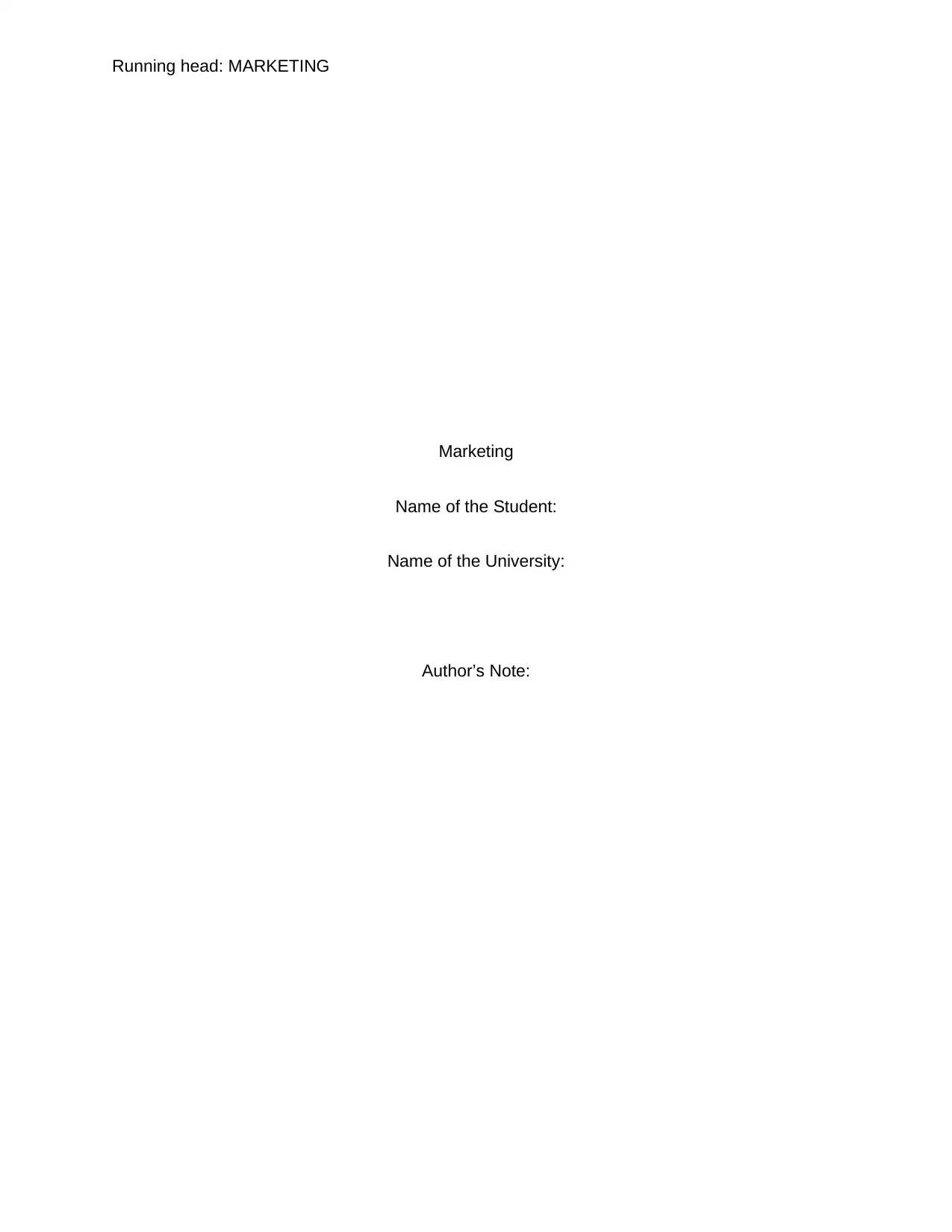
Running head: MARKETING
Marketing
Name of the Student:
Name of the University:
Author’s Note:
Marketing
Name of the Student:
Name of the University:
Author’s Note:
Paraphrase This Document
Need a fresh take? Get an instant paraphrase of this document with our AI Paraphraser
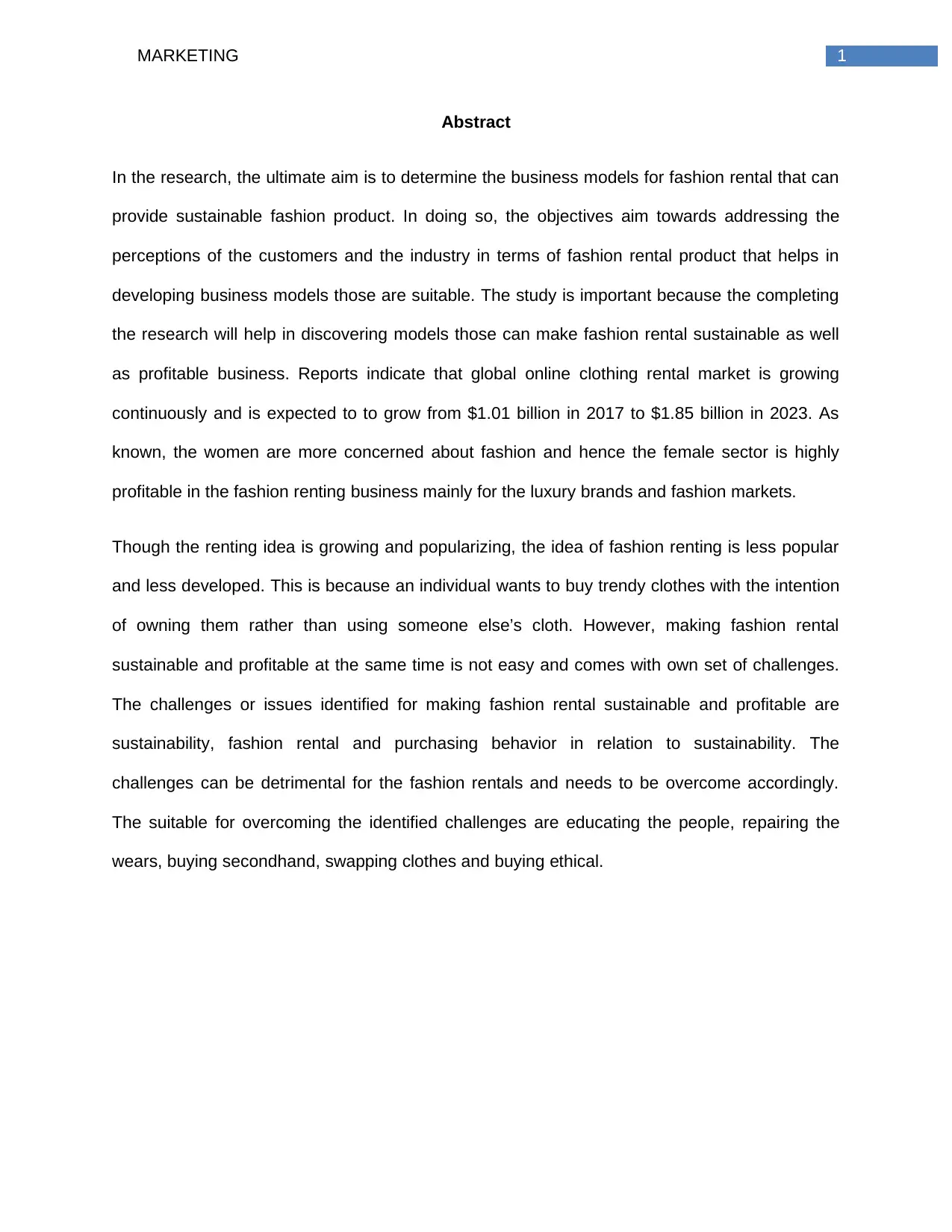
1MARKETING
Abstract
In the research, the ultimate aim is to determine the business models for fashion rental that can
provide sustainable fashion product. In doing so, the objectives aim towards addressing the
perceptions of the customers and the industry in terms of fashion rental product that helps in
developing business models those are suitable. The study is important because the completing
the research will help in discovering models those can make fashion rental sustainable as well
as profitable business. Reports indicate that global online clothing rental market is growing
continuously and is expected to to grow from $1.01 billion in 2017 to $1.85 billion in 2023. As
known, the women are more concerned about fashion and hence the female sector is highly
profitable in the fashion renting business mainly for the luxury brands and fashion markets.
Though the renting idea is growing and popularizing, the idea of fashion renting is less popular
and less developed. This is because an individual wants to buy trendy clothes with the intention
of owning them rather than using someone else’s cloth. However, making fashion rental
sustainable and profitable at the same time is not easy and comes with own set of challenges.
The challenges or issues identified for making fashion rental sustainable and profitable are
sustainability, fashion rental and purchasing behavior in relation to sustainability. The
challenges can be detrimental for the fashion rentals and needs to be overcome accordingly.
The suitable for overcoming the identified challenges are educating the people, repairing the
wears, buying secondhand, swapping clothes and buying ethical.
Abstract
In the research, the ultimate aim is to determine the business models for fashion rental that can
provide sustainable fashion product. In doing so, the objectives aim towards addressing the
perceptions of the customers and the industry in terms of fashion rental product that helps in
developing business models those are suitable. The study is important because the completing
the research will help in discovering models those can make fashion rental sustainable as well
as profitable business. Reports indicate that global online clothing rental market is growing
continuously and is expected to to grow from $1.01 billion in 2017 to $1.85 billion in 2023. As
known, the women are more concerned about fashion and hence the female sector is highly
profitable in the fashion renting business mainly for the luxury brands and fashion markets.
Though the renting idea is growing and popularizing, the idea of fashion renting is less popular
and less developed. This is because an individual wants to buy trendy clothes with the intention
of owning them rather than using someone else’s cloth. However, making fashion rental
sustainable and profitable at the same time is not easy and comes with own set of challenges.
The challenges or issues identified for making fashion rental sustainable and profitable are
sustainability, fashion rental and purchasing behavior in relation to sustainability. The
challenges can be detrimental for the fashion rentals and needs to be overcome accordingly.
The suitable for overcoming the identified challenges are educating the people, repairing the
wears, buying secondhand, swapping clothes and buying ethical.
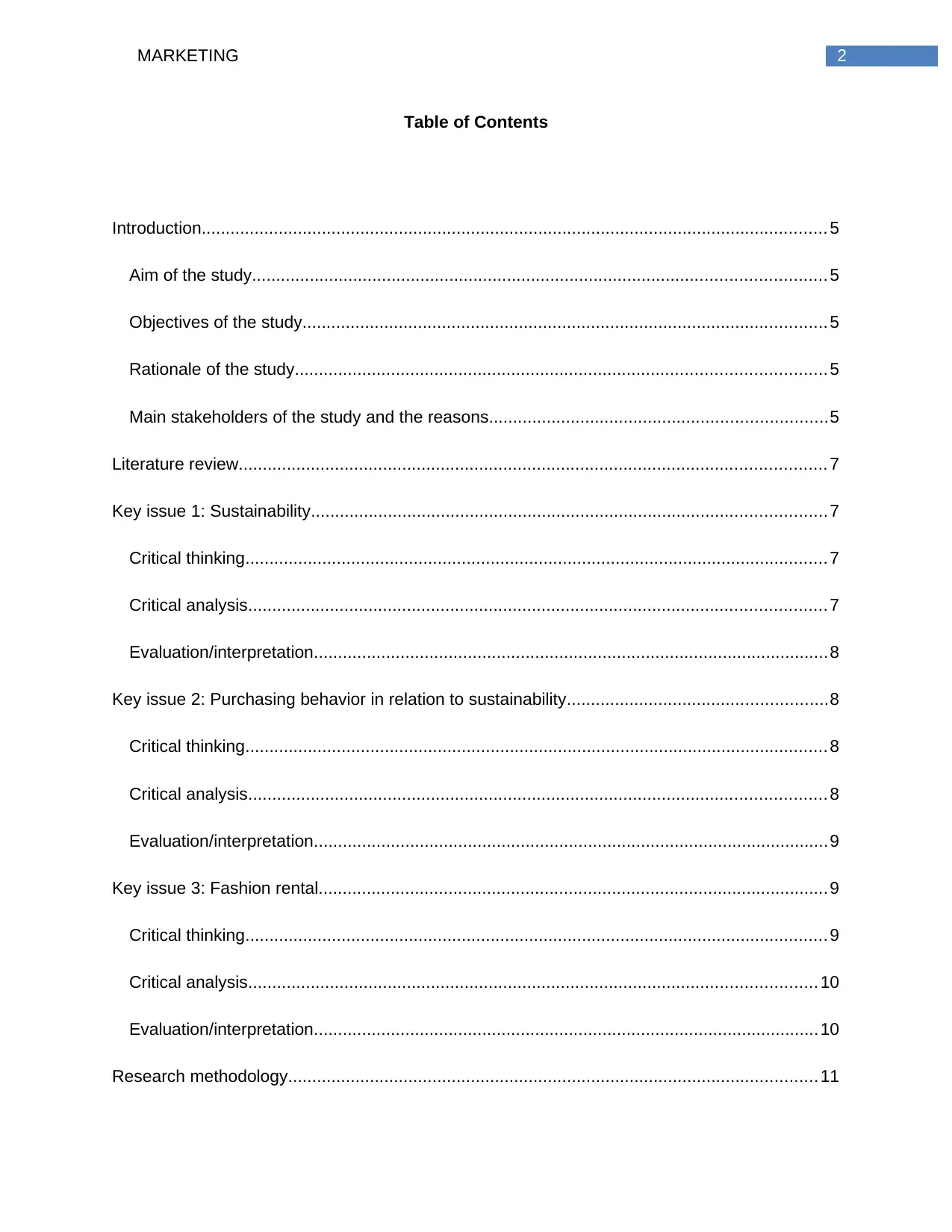
2MARKETING
Table of Contents
Introduction.................................................................................................................................. 5
Aim of the study....................................................................................................................... 5
Objectives of the study............................................................................................................. 5
Rationale of the study.............................................................................................................. 5
Main stakeholders of the study and the reasons......................................................................5
Literature review.......................................................................................................................... 7
Key issue 1: Sustainability........................................................................................................... 7
Critical thinking......................................................................................................................... 7
Critical analysis........................................................................................................................ 7
Evaluation/interpretation...........................................................................................................8
Key issue 2: Purchasing behavior in relation to sustainability......................................................8
Critical thinking......................................................................................................................... 8
Critical analysis........................................................................................................................ 8
Evaluation/interpretation...........................................................................................................9
Key issue 3: Fashion rental..........................................................................................................9
Critical thinking......................................................................................................................... 9
Critical analysis...................................................................................................................... 10
Evaluation/interpretation.........................................................................................................10
Research methodology.............................................................................................................. 11
Table of Contents
Introduction.................................................................................................................................. 5
Aim of the study....................................................................................................................... 5
Objectives of the study............................................................................................................. 5
Rationale of the study.............................................................................................................. 5
Main stakeholders of the study and the reasons......................................................................5
Literature review.......................................................................................................................... 7
Key issue 1: Sustainability........................................................................................................... 7
Critical thinking......................................................................................................................... 7
Critical analysis........................................................................................................................ 7
Evaluation/interpretation...........................................................................................................8
Key issue 2: Purchasing behavior in relation to sustainability......................................................8
Critical thinking......................................................................................................................... 8
Critical analysis........................................................................................................................ 8
Evaluation/interpretation...........................................................................................................9
Key issue 3: Fashion rental..........................................................................................................9
Critical thinking......................................................................................................................... 9
Critical analysis...................................................................................................................... 10
Evaluation/interpretation.........................................................................................................10
Research methodology.............................................................................................................. 11
⊘ This is a preview!⊘
Do you want full access?
Subscribe today to unlock all pages.

Trusted by 1+ million students worldwide
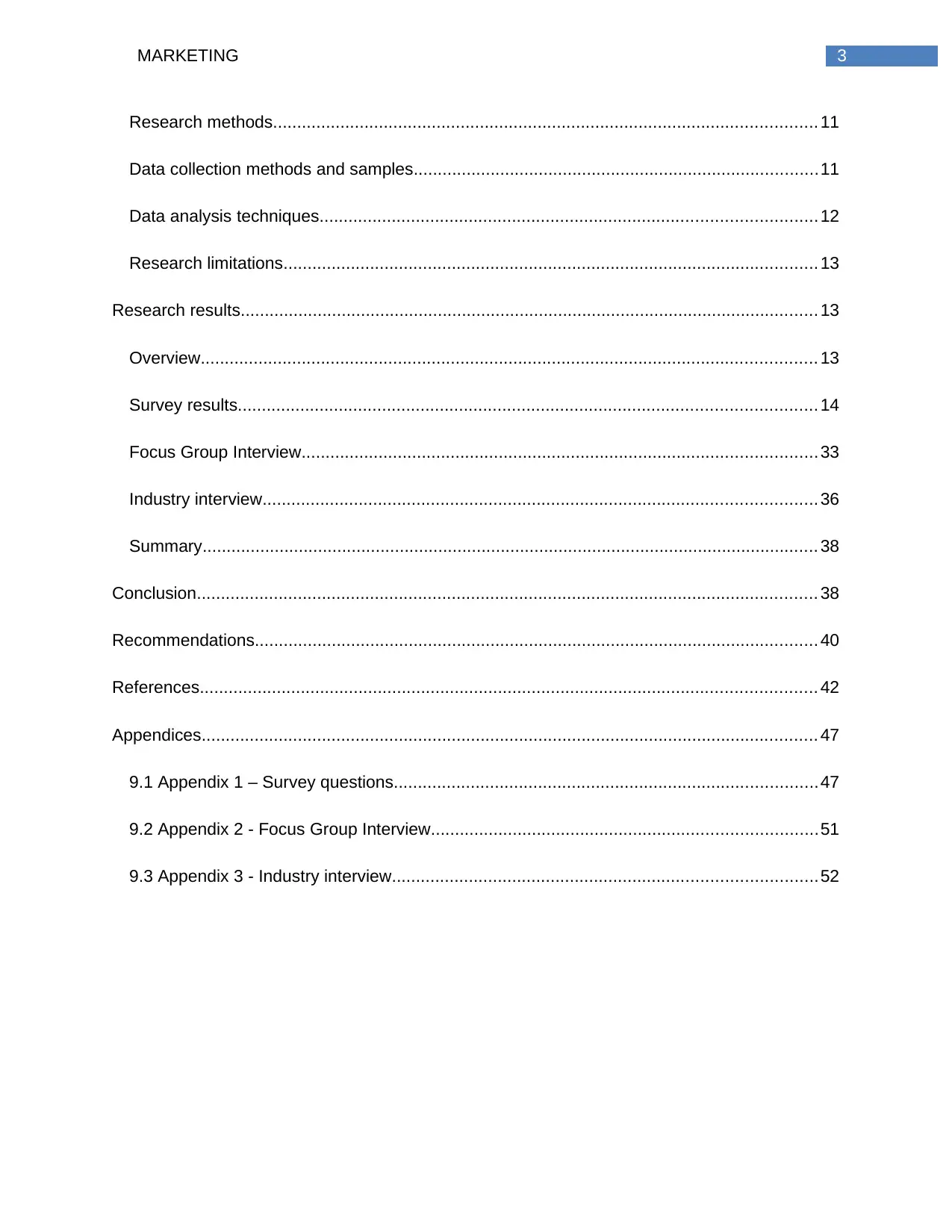
3MARKETING
Research methods................................................................................................................. 11
Data collection methods and samples....................................................................................11
Data analysis techniques.......................................................................................................12
Research limitations............................................................................................................... 13
Research results........................................................................................................................ 13
Overview................................................................................................................................ 13
Survey results........................................................................................................................ 14
Focus Group Interview........................................................................................................... 33
Industry interview................................................................................................................... 36
Summary................................................................................................................................ 38
Conclusion................................................................................................................................. 38
Recommendations..................................................................................................................... 40
References................................................................................................................................ 42
Appendices................................................................................................................................ 47
9.1 Appendix 1 – Survey questions........................................................................................47
9.2 Appendix 2 - Focus Group Interview................................................................................51
9.3 Appendix 3 - Industry interview........................................................................................52
Research methods................................................................................................................. 11
Data collection methods and samples....................................................................................11
Data analysis techniques.......................................................................................................12
Research limitations............................................................................................................... 13
Research results........................................................................................................................ 13
Overview................................................................................................................................ 13
Survey results........................................................................................................................ 14
Focus Group Interview........................................................................................................... 33
Industry interview................................................................................................................... 36
Summary................................................................................................................................ 38
Conclusion................................................................................................................................. 38
Recommendations..................................................................................................................... 40
References................................................................................................................................ 42
Appendices................................................................................................................................ 47
9.1 Appendix 1 – Survey questions........................................................................................47
9.2 Appendix 2 - Focus Group Interview................................................................................51
9.3 Appendix 3 - Industry interview........................................................................................52
Paraphrase This Document
Need a fresh take? Get an instant paraphrase of this document with our AI Paraphraser
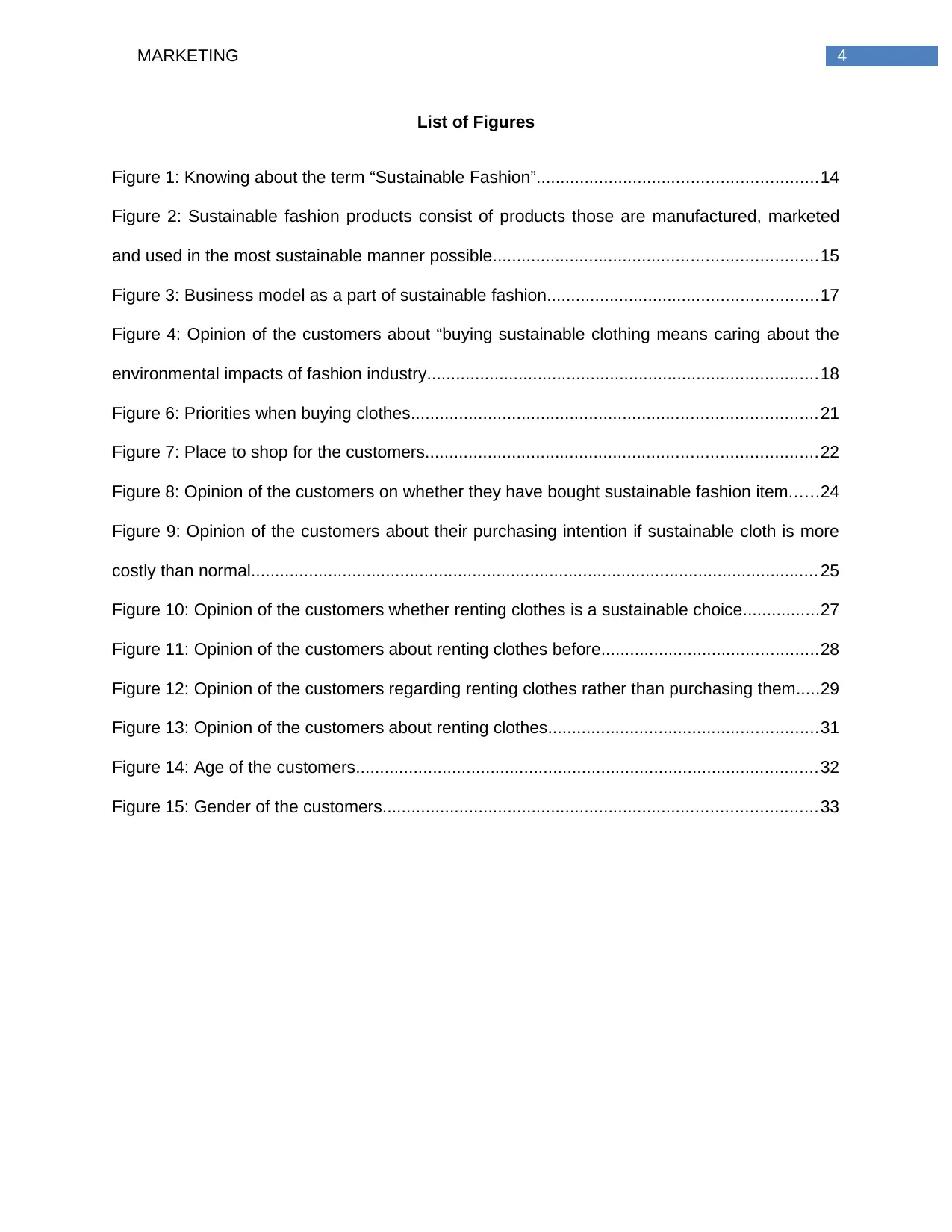
4MARKETING
List of Figures
Figure 1: Knowing about the term “Sustainable Fashion”..........................................................14
Figure 2: Sustainable fashion products consist of products those are manufactured, marketed
and used in the most sustainable manner possible...................................................................15
Figure 3: Business model as a part of sustainable fashion........................................................17
Figure 4: Opinion of the customers about “buying sustainable clothing means caring about the
environmental impacts of fashion industry.................................................................................18
Figure 6: Priorities when buying clothes....................................................................................21
Figure 7: Place to shop for the customers.................................................................................22
Figure 8: Opinion of the customers on whether they have bought sustainable fashion item......24
Figure 9: Opinion of the customers about their purchasing intention if sustainable cloth is more
costly than normal...................................................................................................................... 25
Figure 10: Opinion of the customers whether renting clothes is a sustainable choice................27
Figure 11: Opinion of the customers about renting clothes before.............................................28
Figure 12: Opinion of the customers regarding renting clothes rather than purchasing them.....29
Figure 13: Opinion of the customers about renting clothes........................................................31
Figure 14: Age of the customers................................................................................................32
Figure 15: Gender of the customers..........................................................................................33
List of Figures
Figure 1: Knowing about the term “Sustainable Fashion”..........................................................14
Figure 2: Sustainable fashion products consist of products those are manufactured, marketed
and used in the most sustainable manner possible...................................................................15
Figure 3: Business model as a part of sustainable fashion........................................................17
Figure 4: Opinion of the customers about “buying sustainable clothing means caring about the
environmental impacts of fashion industry.................................................................................18
Figure 6: Priorities when buying clothes....................................................................................21
Figure 7: Place to shop for the customers.................................................................................22
Figure 8: Opinion of the customers on whether they have bought sustainable fashion item......24
Figure 9: Opinion of the customers about their purchasing intention if sustainable cloth is more
costly than normal...................................................................................................................... 25
Figure 10: Opinion of the customers whether renting clothes is a sustainable choice................27
Figure 11: Opinion of the customers about renting clothes before.............................................28
Figure 12: Opinion of the customers regarding renting clothes rather than purchasing them.....29
Figure 13: Opinion of the customers about renting clothes........................................................31
Figure 14: Age of the customers................................................................................................32
Figure 15: Gender of the customers..........................................................................................33
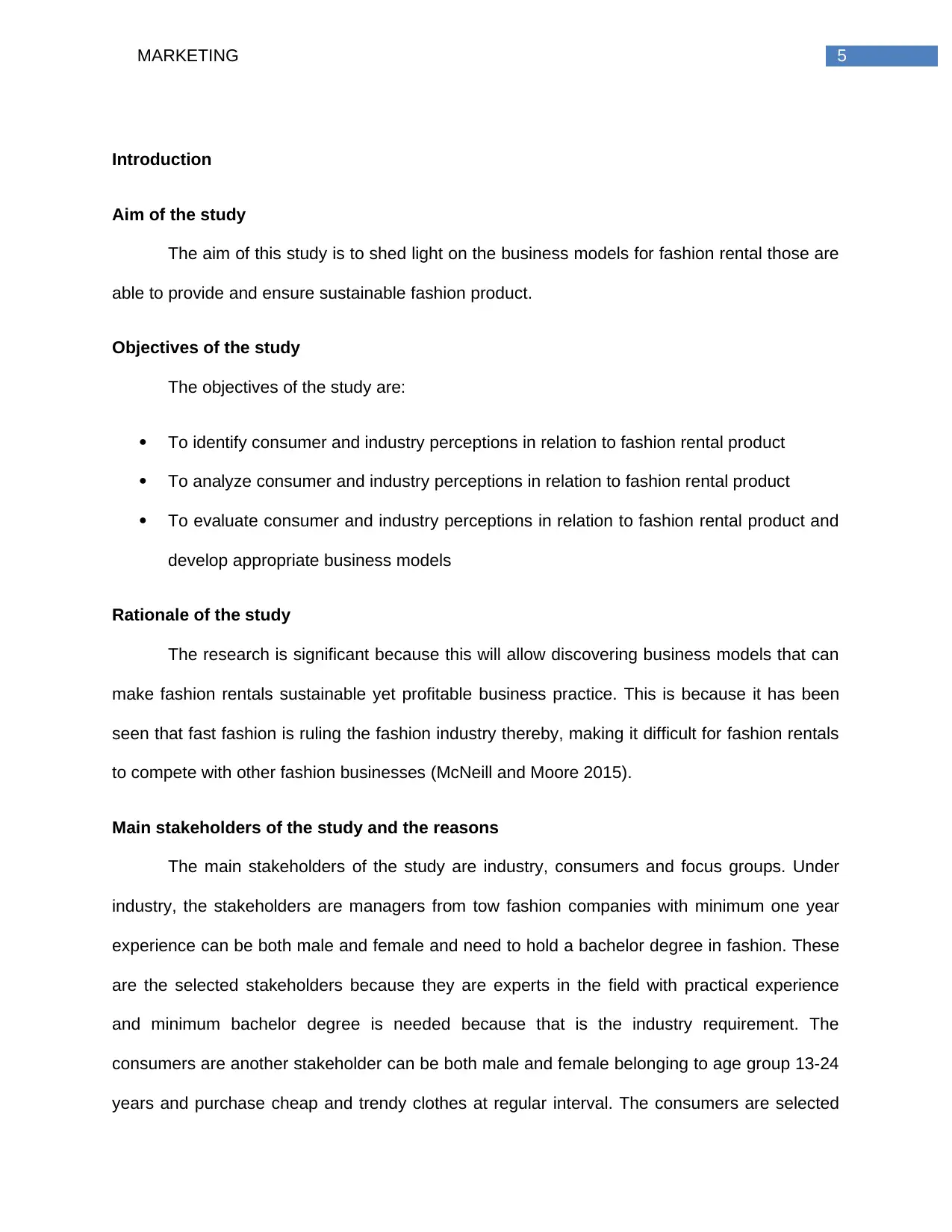
5MARKETING
Introduction
Aim of the study
The aim of this study is to shed light on the business models for fashion rental those are
able to provide and ensure sustainable fashion product.
Objectives of the study
The objectives of the study are:
To identify consumer and industry perceptions in relation to fashion rental product
To analyze consumer and industry perceptions in relation to fashion rental product
To evaluate consumer and industry perceptions in relation to fashion rental product and
develop appropriate business models
Rationale of the study
The research is significant because this will allow discovering business models that can
make fashion rentals sustainable yet profitable business practice. This is because it has been
seen that fast fashion is ruling the fashion industry thereby, making it difficult for fashion rentals
to compete with other fashion businesses (McNeill and Moore 2015).
Main stakeholders of the study and the reasons
The main stakeholders of the study are industry, consumers and focus groups. Under
industry, the stakeholders are managers from tow fashion companies with minimum one year
experience can be both male and female and need to hold a bachelor degree in fashion. These
are the selected stakeholders because they are experts in the field with practical experience
and minimum bachelor degree is needed because that is the industry requirement. The
consumers are another stakeholder can be both male and female belonging to age group 13-24
years and purchase cheap and trendy clothes at regular interval. The consumers are selected
Introduction
Aim of the study
The aim of this study is to shed light on the business models for fashion rental those are
able to provide and ensure sustainable fashion product.
Objectives of the study
The objectives of the study are:
To identify consumer and industry perceptions in relation to fashion rental product
To analyze consumer and industry perceptions in relation to fashion rental product
To evaluate consumer and industry perceptions in relation to fashion rental product and
develop appropriate business models
Rationale of the study
The research is significant because this will allow discovering business models that can
make fashion rentals sustainable yet profitable business practice. This is because it has been
seen that fast fashion is ruling the fashion industry thereby, making it difficult for fashion rentals
to compete with other fashion businesses (McNeill and Moore 2015).
Main stakeholders of the study and the reasons
The main stakeholders of the study are industry, consumers and focus groups. Under
industry, the stakeholders are managers from tow fashion companies with minimum one year
experience can be both male and female and need to hold a bachelor degree in fashion. These
are the selected stakeholders because they are experts in the field with practical experience
and minimum bachelor degree is needed because that is the industry requirement. The
consumers are another stakeholder can be both male and female belonging to age group 13-24
years and purchase cheap and trendy clothes at regular interval. The consumers are selected
⊘ This is a preview!⊘
Do you want full access?
Subscribe today to unlock all pages.

Trusted by 1+ million students worldwide
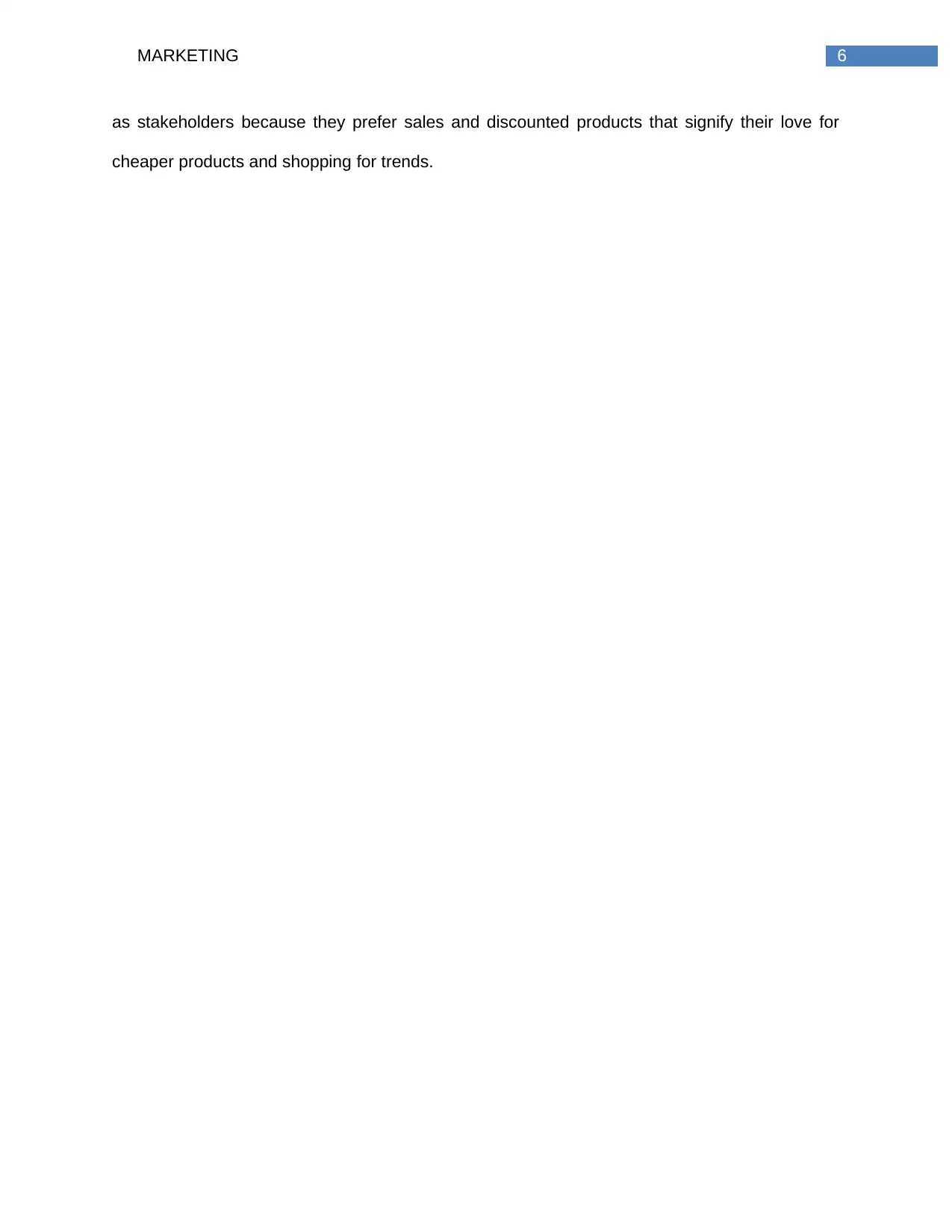
6MARKETING
as stakeholders because they prefer sales and discounted products that signify their love for
cheaper products and shopping for trends.
as stakeholders because they prefer sales and discounted products that signify their love for
cheaper products and shopping for trends.
Paraphrase This Document
Need a fresh take? Get an instant paraphrase of this document with our AI Paraphraser
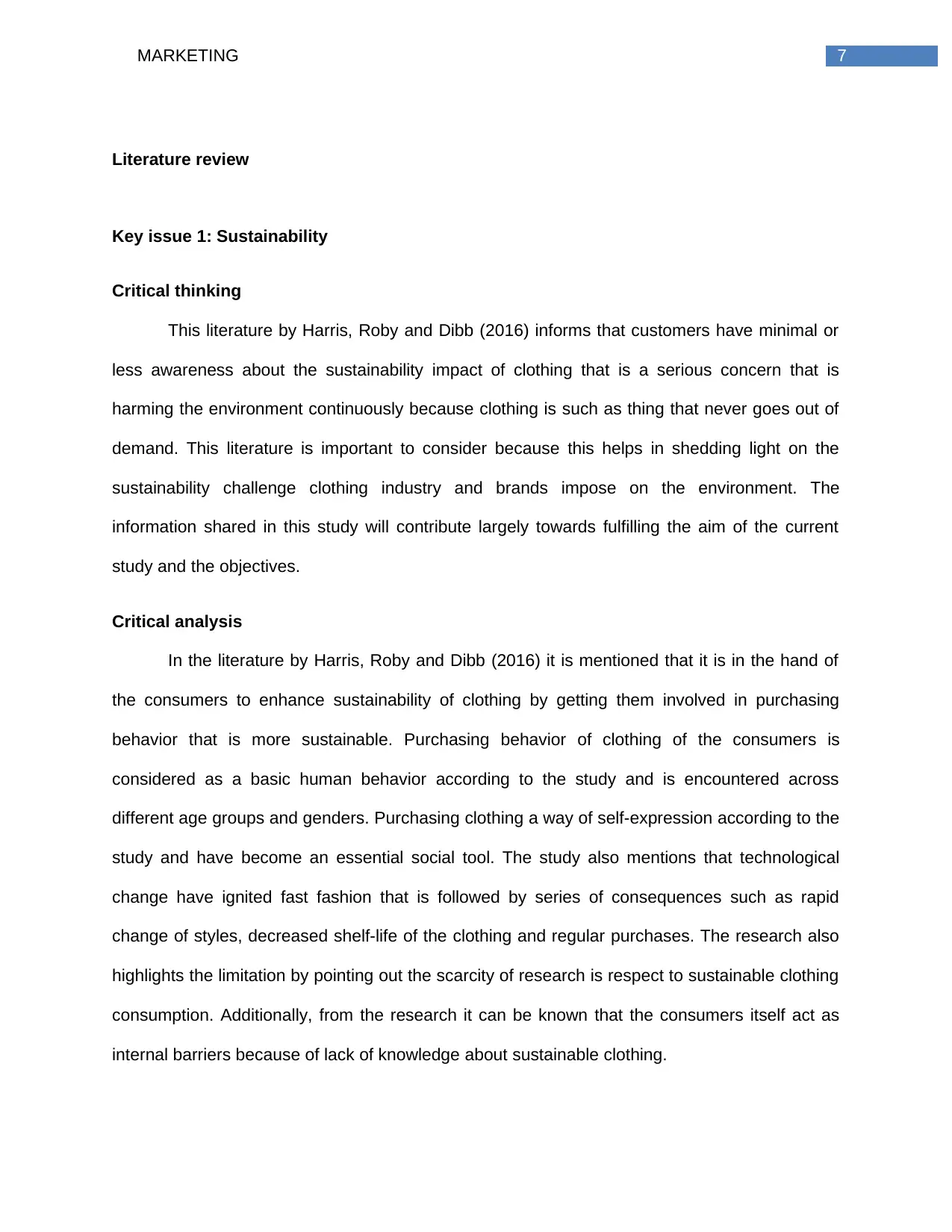
7MARKETING
Literature review
Key issue 1: Sustainability
Critical thinking
This literature by Harris, Roby and Dibb (2016) informs that customers have minimal or
less awareness about the sustainability impact of clothing that is a serious concern that is
harming the environment continuously because clothing is such as thing that never goes out of
demand. This literature is important to consider because this helps in shedding light on the
sustainability challenge clothing industry and brands impose on the environment. The
information shared in this study will contribute largely towards fulfilling the aim of the current
study and the objectives.
Critical analysis
In the literature by Harris, Roby and Dibb (2016) it is mentioned that it is in the hand of
the consumers to enhance sustainability of clothing by getting them involved in purchasing
behavior that is more sustainable. Purchasing behavior of clothing of the consumers is
considered as a basic human behavior according to the study and is encountered across
different age groups and genders. Purchasing clothing a way of self-expression according to the
study and have become an essential social tool. The study also mentions that technological
change have ignited fast fashion that is followed by series of consequences such as rapid
change of styles, decreased shelf-life of the clothing and regular purchases. The research also
highlights the limitation by pointing out the scarcity of research is respect to sustainable clothing
consumption. Additionally, from the research it can be known that the consumers itself act as
internal barriers because of lack of knowledge about sustainable clothing.
Literature review
Key issue 1: Sustainability
Critical thinking
This literature by Harris, Roby and Dibb (2016) informs that customers have minimal or
less awareness about the sustainability impact of clothing that is a serious concern that is
harming the environment continuously because clothing is such as thing that never goes out of
demand. This literature is important to consider because this helps in shedding light on the
sustainability challenge clothing industry and brands impose on the environment. The
information shared in this study will contribute largely towards fulfilling the aim of the current
study and the objectives.
Critical analysis
In the literature by Harris, Roby and Dibb (2016) it is mentioned that it is in the hand of
the consumers to enhance sustainability of clothing by getting them involved in purchasing
behavior that is more sustainable. Purchasing behavior of clothing of the consumers is
considered as a basic human behavior according to the study and is encountered across
different age groups and genders. Purchasing clothing a way of self-expression according to the
study and have become an essential social tool. The study also mentions that technological
change have ignited fast fashion that is followed by series of consequences such as rapid
change of styles, decreased shelf-life of the clothing and regular purchases. The research also
highlights the limitation by pointing out the scarcity of research is respect to sustainable clothing
consumption. Additionally, from the research it can be known that the consumers itself act as
internal barriers because of lack of knowledge about sustainable clothing.
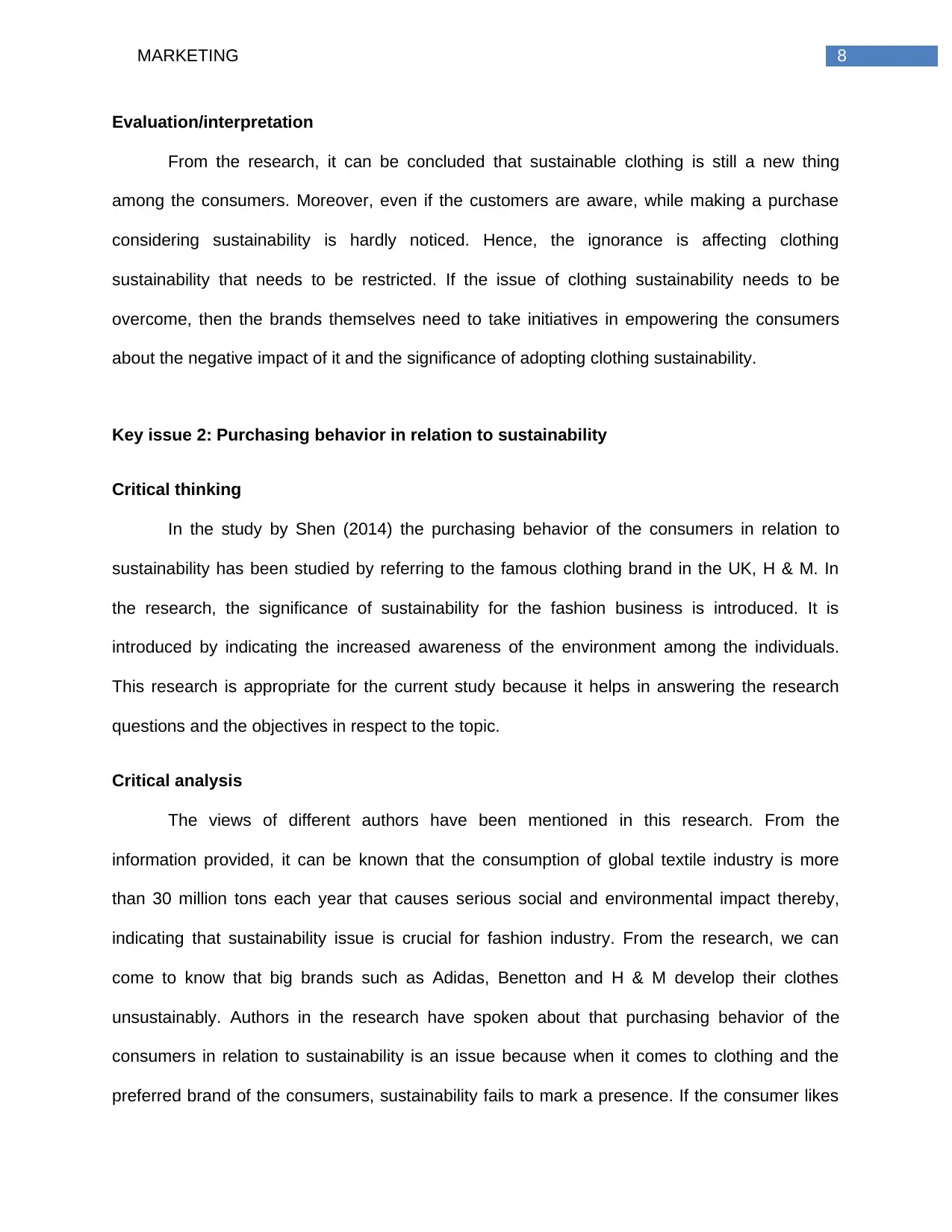
8MARKETING
Evaluation/interpretation
From the research, it can be concluded that sustainable clothing is still a new thing
among the consumers. Moreover, even if the customers are aware, while making a purchase
considering sustainability is hardly noticed. Hence, the ignorance is affecting clothing
sustainability that needs to be restricted. If the issue of clothing sustainability needs to be
overcome, then the brands themselves need to take initiatives in empowering the consumers
about the negative impact of it and the significance of adopting clothing sustainability.
Key issue 2: Purchasing behavior in relation to sustainability
Critical thinking
In the study by Shen (2014) the purchasing behavior of the consumers in relation to
sustainability has been studied by referring to the famous clothing brand in the UK, H & M. In
the research, the significance of sustainability for the fashion business is introduced. It is
introduced by indicating the increased awareness of the environment among the individuals.
This research is appropriate for the current study because it helps in answering the research
questions and the objectives in respect to the topic.
Critical analysis
The views of different authors have been mentioned in this research. From the
information provided, it can be known that the consumption of global textile industry is more
than 30 million tons each year that causes serious social and environmental impact thereby,
indicating that sustainability issue is crucial for fashion industry. From the research, we can
come to know that big brands such as Adidas, Benetton and H & M develop their clothes
unsustainably. Authors in the research have spoken about that purchasing behavior of the
consumers in relation to sustainability is an issue because when it comes to clothing and the
preferred brand of the consumers, sustainability fails to mark a presence. If the consumer likes
Evaluation/interpretation
From the research, it can be concluded that sustainable clothing is still a new thing
among the consumers. Moreover, even if the customers are aware, while making a purchase
considering sustainability is hardly noticed. Hence, the ignorance is affecting clothing
sustainability that needs to be restricted. If the issue of clothing sustainability needs to be
overcome, then the brands themselves need to take initiatives in empowering the consumers
about the negative impact of it and the significance of adopting clothing sustainability.
Key issue 2: Purchasing behavior in relation to sustainability
Critical thinking
In the study by Shen (2014) the purchasing behavior of the consumers in relation to
sustainability has been studied by referring to the famous clothing brand in the UK, H & M. In
the research, the significance of sustainability for the fashion business is introduced. It is
introduced by indicating the increased awareness of the environment among the individuals.
This research is appropriate for the current study because it helps in answering the research
questions and the objectives in respect to the topic.
Critical analysis
The views of different authors have been mentioned in this research. From the
information provided, it can be known that the consumption of global textile industry is more
than 30 million tons each year that causes serious social and environmental impact thereby,
indicating that sustainability issue is crucial for fashion industry. From the research, we can
come to know that big brands such as Adidas, Benetton and H & M develop their clothes
unsustainably. Authors in the research have spoken about that purchasing behavior of the
consumers in relation to sustainability is an issue because when it comes to clothing and the
preferred brand of the consumers, sustainability fails to mark a presence. If the consumer likes
⊘ This is a preview!⊘
Do you want full access?
Subscribe today to unlock all pages.

Trusted by 1+ million students worldwide
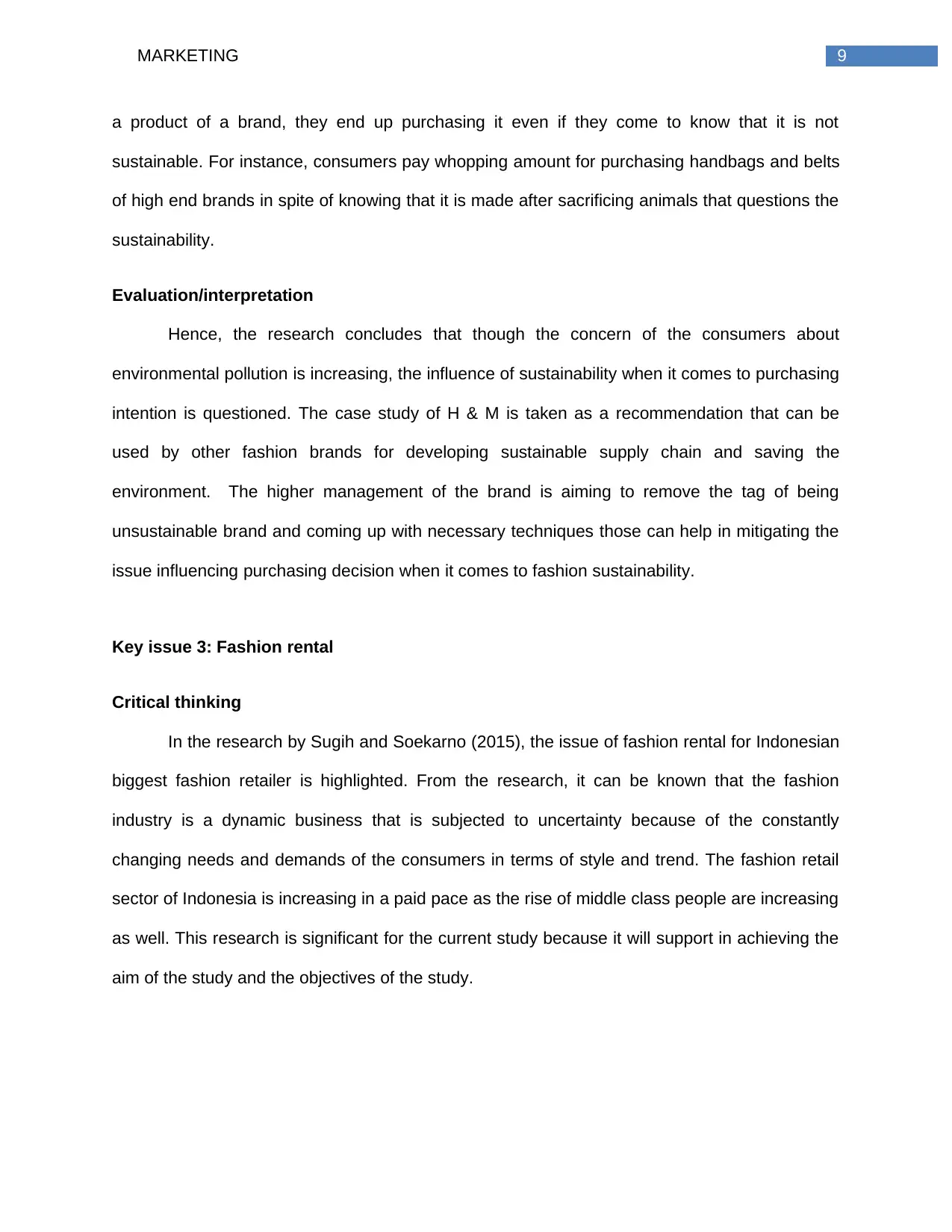
9MARKETING
a product of a brand, they end up purchasing it even if they come to know that it is not
sustainable. For instance, consumers pay whopping amount for purchasing handbags and belts
of high end brands in spite of knowing that it is made after sacrificing animals that questions the
sustainability.
Evaluation/interpretation
Hence, the research concludes that though the concern of the consumers about
environmental pollution is increasing, the influence of sustainability when it comes to purchasing
intention is questioned. The case study of H & M is taken as a recommendation that can be
used by other fashion brands for developing sustainable supply chain and saving the
environment. The higher management of the brand is aiming to remove the tag of being
unsustainable brand and coming up with necessary techniques those can help in mitigating the
issue influencing purchasing decision when it comes to fashion sustainability.
Key issue 3: Fashion rental
Critical thinking
In the research by Sugih and Soekarno (2015), the issue of fashion rental for Indonesian
biggest fashion retailer is highlighted. From the research, it can be known that the fashion
industry is a dynamic business that is subjected to uncertainty because of the constantly
changing needs and demands of the consumers in terms of style and trend. The fashion retail
sector of Indonesia is increasing in a paid pace as the rise of middle class people are increasing
as well. This research is significant for the current study because it will support in achieving the
aim of the study and the objectives of the study.
a product of a brand, they end up purchasing it even if they come to know that it is not
sustainable. For instance, consumers pay whopping amount for purchasing handbags and belts
of high end brands in spite of knowing that it is made after sacrificing animals that questions the
sustainability.
Evaluation/interpretation
Hence, the research concludes that though the concern of the consumers about
environmental pollution is increasing, the influence of sustainability when it comes to purchasing
intention is questioned. The case study of H & M is taken as a recommendation that can be
used by other fashion brands for developing sustainable supply chain and saving the
environment. The higher management of the brand is aiming to remove the tag of being
unsustainable brand and coming up with necessary techniques those can help in mitigating the
issue influencing purchasing decision when it comes to fashion sustainability.
Key issue 3: Fashion rental
Critical thinking
In the research by Sugih and Soekarno (2015), the issue of fashion rental for Indonesian
biggest fashion retailer is highlighted. From the research, it can be known that the fashion
industry is a dynamic business that is subjected to uncertainty because of the constantly
changing needs and demands of the consumers in terms of style and trend. The fashion retail
sector of Indonesia is increasing in a paid pace as the rise of middle class people are increasing
as well. This research is significant for the current study because it will support in achieving the
aim of the study and the objectives of the study.
Paraphrase This Document
Need a fresh take? Get an instant paraphrase of this document with our AI Paraphraser
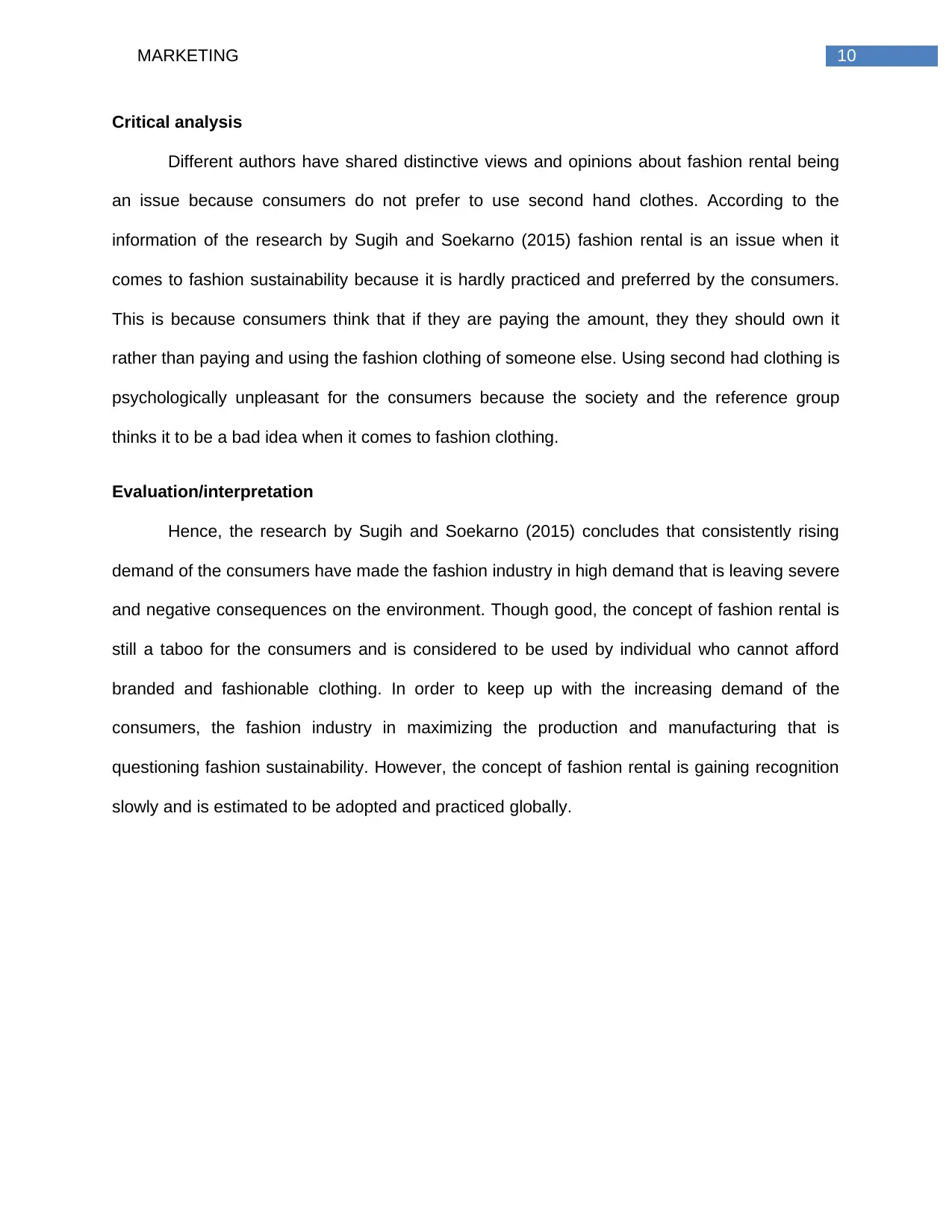
10MARKETING
Critical analysis
Different authors have shared distinctive views and opinions about fashion rental being
an issue because consumers do not prefer to use second hand clothes. According to the
information of the research by Sugih and Soekarno (2015) fashion rental is an issue when it
comes to fashion sustainability because it is hardly practiced and preferred by the consumers.
This is because consumers think that if they are paying the amount, they they should own it
rather than paying and using the fashion clothing of someone else. Using second had clothing is
psychologically unpleasant for the consumers because the society and the reference group
thinks it to be a bad idea when it comes to fashion clothing.
Evaluation/interpretation
Hence, the research by Sugih and Soekarno (2015) concludes that consistently rising
demand of the consumers have made the fashion industry in high demand that is leaving severe
and negative consequences on the environment. Though good, the concept of fashion rental is
still a taboo for the consumers and is considered to be used by individual who cannot afford
branded and fashionable clothing. In order to keep up with the increasing demand of the
consumers, the fashion industry in maximizing the production and manufacturing that is
questioning fashion sustainability. However, the concept of fashion rental is gaining recognition
slowly and is estimated to be adopted and practiced globally.
Critical analysis
Different authors have shared distinctive views and opinions about fashion rental being
an issue because consumers do not prefer to use second hand clothes. According to the
information of the research by Sugih and Soekarno (2015) fashion rental is an issue when it
comes to fashion sustainability because it is hardly practiced and preferred by the consumers.
This is because consumers think that if they are paying the amount, they they should own it
rather than paying and using the fashion clothing of someone else. Using second had clothing is
psychologically unpleasant for the consumers because the society and the reference group
thinks it to be a bad idea when it comes to fashion clothing.
Evaluation/interpretation
Hence, the research by Sugih and Soekarno (2015) concludes that consistently rising
demand of the consumers have made the fashion industry in high demand that is leaving severe
and negative consequences on the environment. Though good, the concept of fashion rental is
still a taboo for the consumers and is considered to be used by individual who cannot afford
branded and fashionable clothing. In order to keep up with the increasing demand of the
consumers, the fashion industry in maximizing the production and manufacturing that is
questioning fashion sustainability. However, the concept of fashion rental is gaining recognition
slowly and is estimated to be adopted and practiced globally.
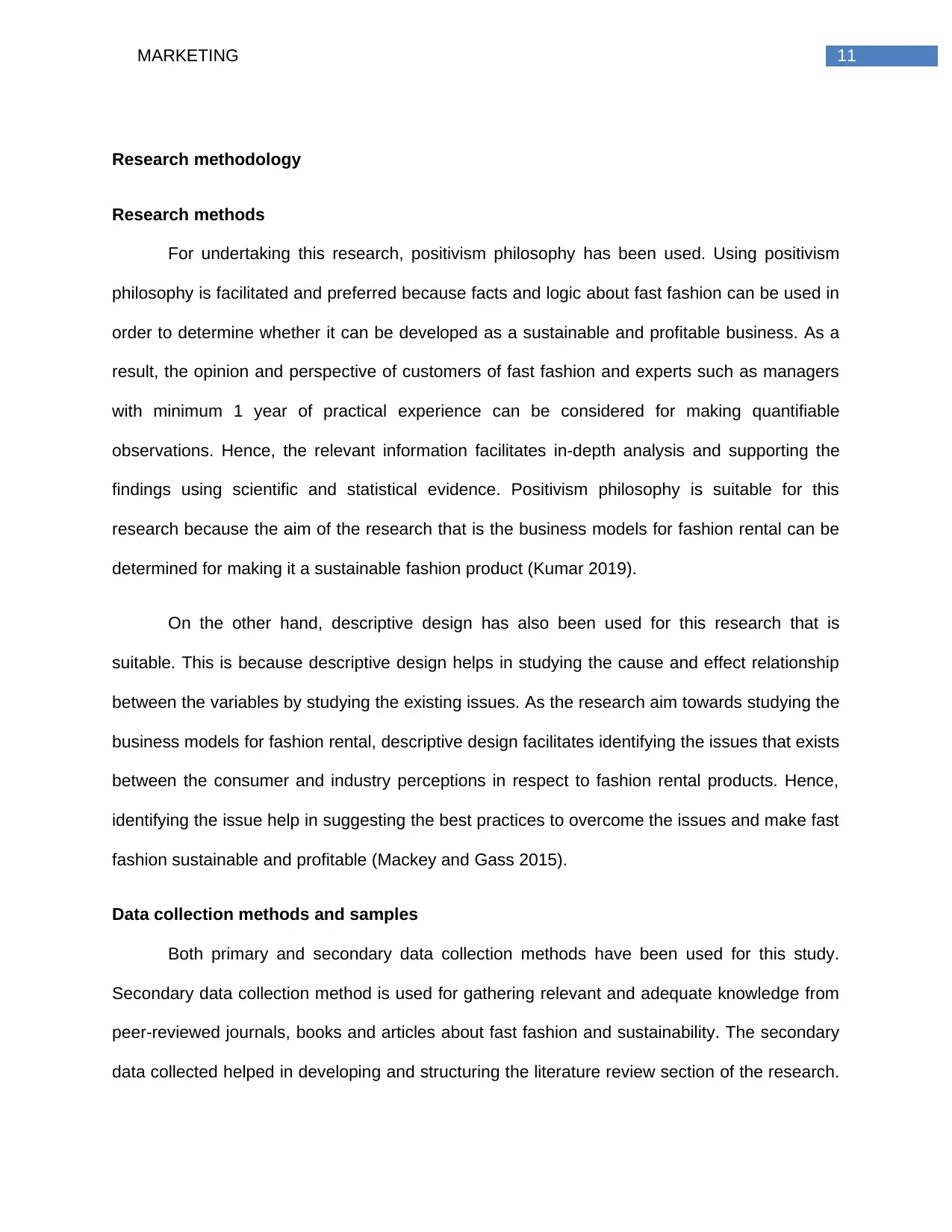
11MARKETING
Research methodology
Research methods
For undertaking this research, positivism philosophy has been used. Using positivism
philosophy is facilitated and preferred because facts and logic about fast fashion can be used in
order to determine whether it can be developed as a sustainable and profitable business. As a
result, the opinion and perspective of customers of fast fashion and experts such as managers
with minimum 1 year of practical experience can be considered for making quantifiable
observations. Hence, the relevant information facilitates in-depth analysis and supporting the
findings using scientific and statistical evidence. Positivism philosophy is suitable for this
research because the aim of the research that is the business models for fashion rental can be
determined for making it a sustainable fashion product (Kumar 2019).
On the other hand, descriptive design has also been used for this research that is
suitable. This is because descriptive design helps in studying the cause and effect relationship
between the variables by studying the existing issues. As the research aim towards studying the
business models for fashion rental, descriptive design facilitates identifying the issues that exists
between the consumer and industry perceptions in respect to fashion rental products. Hence,
identifying the issue help in suggesting the best practices to overcome the issues and make fast
fashion sustainable and profitable (Mackey and Gass 2015).
Data collection methods and samples
Both primary and secondary data collection methods have been used for this study.
Secondary data collection method is used for gathering relevant and adequate knowledge from
peer-reviewed journals, books and articles about fast fashion and sustainability. The secondary
data collected helped in developing and structuring the literature review section of the research.
Research methodology
Research methods
For undertaking this research, positivism philosophy has been used. Using positivism
philosophy is facilitated and preferred because facts and logic about fast fashion can be used in
order to determine whether it can be developed as a sustainable and profitable business. As a
result, the opinion and perspective of customers of fast fashion and experts such as managers
with minimum 1 year of practical experience can be considered for making quantifiable
observations. Hence, the relevant information facilitates in-depth analysis and supporting the
findings using scientific and statistical evidence. Positivism philosophy is suitable for this
research because the aim of the research that is the business models for fashion rental can be
determined for making it a sustainable fashion product (Kumar 2019).
On the other hand, descriptive design has also been used for this research that is
suitable. This is because descriptive design helps in studying the cause and effect relationship
between the variables by studying the existing issues. As the research aim towards studying the
business models for fashion rental, descriptive design facilitates identifying the issues that exists
between the consumer and industry perceptions in respect to fashion rental products. Hence,
identifying the issue help in suggesting the best practices to overcome the issues and make fast
fashion sustainable and profitable (Mackey and Gass 2015).
Data collection methods and samples
Both primary and secondary data collection methods have been used for this study.
Secondary data collection method is used for gathering relevant and adequate knowledge from
peer-reviewed journals, books and articles about fast fashion and sustainability. The secondary
data collected helped in developing and structuring the literature review section of the research.
⊘ This is a preview!⊘
Do you want full access?
Subscribe today to unlock all pages.

Trusted by 1+ million students worldwide
1 out of 53
Related Documents
Your All-in-One AI-Powered Toolkit for Academic Success.
+13062052269
info@desklib.com
Available 24*7 on WhatsApp / Email
![[object Object]](/_next/static/media/star-bottom.7253800d.svg)
Unlock your academic potential
Copyright © 2020–2025 A2Z Services. All Rights Reserved. Developed and managed by ZUCOL.





